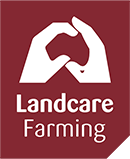Galong producer Danny Flanery is demonstrating it’s possible to create significant landscape change and transform unproductive land into sustainable, profitable food and fibre producing area in a single lifetime.
Danny Flanery and his family have farmed their 2000ha NSW property ‘Boorowa Flats’ for about 100 years. With the support of local Landcare groups Harden Murrumburrah Landcare and Boorowa Landcare Group, he has transformed the fine wool, wether lamb, cattle and cropping (canola and wheat) farm enterprise into a thriving business and won the 2012 Primary Producer National Landcare Award and the 2023 Boorowa Community Landcare Group Award.
“It’s really satisfying to get awards, but that’s not why I did it,” Danny said. “I did it to change my farm from being an unproductive farm to a productive farm, and landcare helped me get to that point.”
21 years ago, Danny took a $50 helicopter ride at Boorowa Show and used the opportunity to take photos of his property from the air. Boorowa and the surrounding area had been in an intense period of drought for 10 years, and while Danny was already concerned by the soil erosion he could see on the property, when he got the photos developed, he was shocked by what he saw.
From the photos, Danny could see salt flats forming on the ground, significant patches of erosion, a large number of dead and dying trees and substantial areas covered in serrated tussock (Nassella trichotoma).
“I very quickly realized that our farm was in a lot of trouble,” said Danny. “We couldn’t even farm it. Nothing grew in there so stock couldn’t graze it. It was just dead to us.”
Danny immediately contacted Louise Hufton, then Coordinator of Harden Murrumburrah Landcare Group, for help and they began to devise a plan to address the land degradation and revegetate the farm.
To create the landscape change needed to transform his business, Danny put aside 350ha of his property for dedicated landcare projects. This included:
- Planting 300,000 trees and shrubs including Phalaris sp., Casuarina sp., Melaleuca sp., and native eucalypt;
- Installing 40km of fencing to protect remnant vegetation and revegetated areas; and
- Undertaking 50ha of pasture revegetation with sowing a lucerne, clover, phalaris and rye mix, and holistically managing his grazing
Danny saw results almost immediately. Erosion was diminished, the serrated tussock was reduced by around 90% and soil quality improved through the increase in groundcover, which also helped to improve the quality of his wool due to less dust in the environment. Through a combination of pasture improvement and increased shelter from planting, Danny’s lambing percentage also increased from 85% before improvements to 117% in 2023, and he found that because his sheep were healthier more wool was grown.
The improvement in the landscape and being able to see the trees and landscape evolve and thrive in drought conditions also improved Danny’s enjoyment of his farming lifestyle.
“Every single day I go to work, I look at our place and go wow, how good does this place look,” Danny said. “It’s just that extra motivation to get me up every day and doing what I’m doing.”
Danny now hosts field days and farm tours to connect with and inspire other landholders in his community. To improve drought resilience on his property, he also maintains a focus on sustainable grazing management and soil health, both through careful monitoring to maintain 100% groundcover at all times and high-density rotational grazing (up to 14 days grazing and between 60-120 days of rest).
This case study was produced as part of the Landcare Farming Innovations in Agriculture Series. Supported by the Australian Government’s National Landcare Program, the Landcare Farming Innovations in Agriculture Series is managed in partnership by Landcare Australia and the National Landcare Network.



